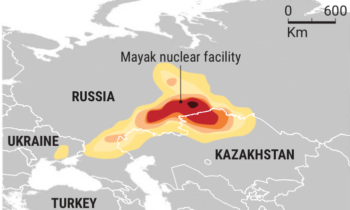 For 2 weeks in September and October last year, traces of the humanmade isotope ruthenium-106 wafted across Europe, triggering detectors from Norway to Greece and Ukraine to Switzerland. The radioactive cloud was too thin to be dangerous, containing no more than a few grams of material, but its origin posed an outsize mystery.
For 2 weeks in September and October last year, traces of the humanmade isotope ruthenium-106 wafted across Europe, triggering detectors from Norway to Greece and Ukraine to Switzerland. The radioactive cloud was too thin to be dangerous, containing no more than a few grams of material, but its origin posed an outsize mystery.
Now, scientists at the French Institute of Radioprotection and Nuclear Security (IRSN) in Paris say the isotope may have been released from the Mayak nuclear facility near Ozyorsk in southern Russia. IRSN argues that the leak could have taken place when Mayak technicians botched the fabrication of a highly radioactive component for a physics experiment at the Gran Sasso National Laboratory in L’Aquila, Italy.
The Russian government and state nuclear operator Rosatom have vehemently denied that an accident took place, however. Meanwhile, an international committee set up by the Russian Academy of Sciences’s Nuclear Safety Institute (IBRAE) in Moscow that met on 31 January is divided over the origins of the pollution.
Based on a computer model that used the air-sampling data and weather patterns, IRSN concluded in early October 2017 that the ruthenium most likely originated in the southern Urals; its German counterpart agreed. The French team went on to rule out a number of potential sources, including a mishap at a nuclear reactor. Such an incident would have spewed many other radioactive pollutants besides ruthenium.
The southern Urals are home to the secretive Mayak facility, the scene of one of the world’s worst nuclear accidents 60 years ago, and speculation soon turned to a possible accident at its reprocessing plant, which extracts isotopes from spent nuclear fuel. The IRSN report, made public on 6 February, says Mayak’s attempt to manufacture a capsule of cerium-144 destined for Gran Sasso “should be investigated” as a possible cause. Scientists at Gran Sasso needed the cerium for a search—now called off—for hypothetical particles called sterile neutrinos.
The estimated amount of radioactive ruthenium released could only have come from processing several tons of spent nuclear fuel, IRSN says. What’s more, the ratio of ruthenium-106 to the faster-decaying isotope ruthenium-103, detected in smaller amounts last autumn, reveals that the fuel must have been removed from its reactor only a year or two earlier. Spent fuel is normally cooled for up to a decade before it is reprocessed, so it seems the plant was preparing material for an application requiring high levels of radioactivity, IRSN says.
That fits the description of the sterile neutrino experiment at Gran Sasso, known as SOX and supported by Italy’s National Institute for Nuclear Physics (INFN) and the French Alternative Energies and Atomic Energy Commission. It required a source that was both extremely radioactive and very small, says SOX spokesperson Marco Pallavicini, a particle physicist at the University of Genoa in Italy. He says Mayak Production Association, the only company able to supply it, signed a contract in fall 2016 to produce a cerium capsule, expected to arrive in early 2018.
But in December 2017 the company stated it could not reach the desired radioactivity level. (“The Russians said absolutely nothing” about a radiation leak, Pallavicini says.) That meant SOX would lack the required sensitivity, and on 1 February, INFN announced it had axed the experiment, in what Pallavicini described as “a big blow” for scientists.
Jean-Christophe Gariel, IRSN’s director of health, says an uncontrolled temperature rise during the separation of cerium from the spent fuel at Mayak might have converted some of the ruthenium in the waste to gaseous ruthenium oxide. That gas would have escaped through the facility’s filters and solidified in the cool outside air, he says, turning into small solid oxide particles that could have wafted across Europe.
IBRAE Director Leonid Bolshov calls IRSN’s scenario “a good hypothesis,” but says it’s incorrect. For one thing, he says, the separation process never reached “the hot phase.” And in any case, he adds, “major operations” on the spent fuel at Mayak were done in late October 2017, after the ruthenium release. Bolshov says that a “rather rare meteorological event” might have transported the ruthenium from an as-yet-unidentified place to the southern Urals, from which it then appeared to spread.
Non-Russian members of IBRAE’s international panel, which is due to meet again in April, support IRSN’s conclusion that the southern Urals is the likely source of the leak, says IRSN physicist Jean-Luc Lachaume, a panel member, although some argue that the region is too large to pinpoint an exact location. Russian members claim the leak could have arisen “in the eastern part of the Russian federation,” Lachaume says. He says a representative of the Russian nuclear regulator Rostechnadzor who inspected Mayak in November 2017 told the panel that he saw no anomalies from a month earlier, but didn’t supply data to support that statement.
Princeton University physicist Frank von Hippel, a nonproliferation expert, says he doesn’t see “anything wrong with the IRSN analysis.” He notes that the amount of ruthenium-106 that the French team estimates was emitted—between 1 gram and 4 grams—matches the 30 grams of cerium-144 required for SOX, given that spent fuel contains the two isotopes in a ratio of about one to 14. And although the cloud over Europe was harmless, an accident at Mayak could mean that people living close by took in “potentially significant lung doses,” Von Hippel says.
(sciencemag)
